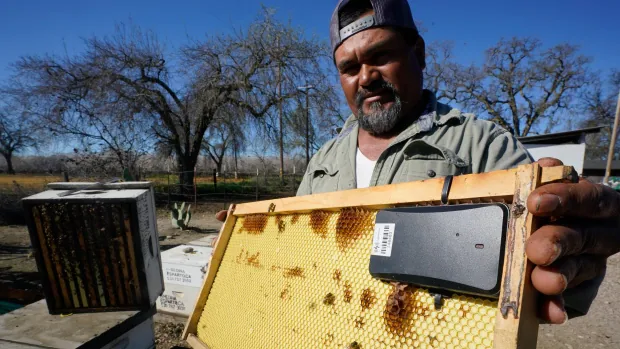For just a few frenzied weeks, beekeepers from round the US truck billions of honeybees to California to lease them to almond growers who want the bugs to pollinate the state’s most beneficial crop.
However as almond timber begin to bloom, blanketing whole valleys in white and pink flowers, so start beehive thefts which have turn into so prevalent that beekeepers at the moment are turning to GPS monitoring gadgets, surveillance cameras and different anti-theft expertise to guard their valuable colonies.
Hive thefts have been reported elsewhere within the nation.
Most lately three hives containing about 60,000 bees have been taken from a grocery chain’s backyard in central Pennsylvania. The thefts occur at a bigger scale and uniquely in California this time of 12 months as a result of bees are most in demand throughout the largest pollination occasion on the planet.
Prior to now few weeks, 1,036 beehives price lots of of hundreds of {dollars} had been reported stolen from orchards statewide, authorities mentioned. The biggest heist concerned 384 beehives that had been taken from a discipline in Mendocino County, prompting the state beekeepers affiliation to supply a $10,000 reward for data resulting in their restoration.
GPS trackers
“It is onerous to articulate the way it feels to care in your hives all 12 months solely to have them stolen from you,” Claire Tauzer wrote on Fb to unfold the phrase concerning the reward.
A day later, an nameless tipster led authorities to get better many of the containers and a forklift stolen from Tauzer’s household enterprise some 88 kilometres away, at a rural property in Yolo County. One suspect was arrested.

Investigators additionally discovered frames, the varieties used to carry the honeycomb, belonging to Helio Medina, one other beekeeper who misplaced 282 hives a 12 months in the past.
Medina mentioned the theft devastated his apiary, so this 12 months he positioned GPS trackers contained in the containers. He additionally strapped cable locks round them and put in cameras close by.
Because the almond bloom approached and the hives grew to become most beneficial, he drove round patrolling the orchards at the hours of darkness.
“We now have to do what we will to guard ourselves. No one might help us,” Medina mentioned.
Thefts often occur at night time, when nobody is within the orchard and the bees are again of their hives. The rustler is often a beekeeper or somebody conversant in the transportation of bees.
Almond reputation makes bees a scorching commodity
“Most of the time, they steal to become profitable and go away the bees to die,” mentioned Rowdy Jay Freeman, a Butte County sheriff’s detective who has been holding monitor of hive thefts since 2013.
A smaller provide of bees and hovering pollination charges — the price has jumped from lower than $50 to lease a hive 20 years in the past to as a lot as $230 per hive this 12 months — are probably motivating beekeepers to go rogue.

The demand for bees as pollinators for almond timber has steadily risen over the past 20 years as reputation of the wholesome, crunchy nut turned California into the world’s greatest almond producer. Accordingly, the quantity of land used to develop almonds has greater than doubled to an estimated 526,000 hectares.
Beekeepers have been maintaining with that development by offering an ever-increasing proportion of the nation’s accessible inventory of hives.
This 12 months, a survey of economic beekeepers estimated it should take 90 per cent of honeybee colonies within the U.S. to pollinate all of the almond orchards.
“What which means is that beekeepers are coming from so far as New York and Florida, and to get them to return all that manner, pollinator charges need to rise,” mentioned Brittney Goodrich, an agriculture economist on the College of California at Davis.
Bee colonies unstable
However bee populations are notoriously unstable because of a bunch of issues, together with illness, lack of habitat and pesticides.
The drought that gripped Western states final summer season additionally weakened colonies. The shortage of rain ravaged wildflowers that present the nectar that bees flip into honey. Beekeepers needed to artificially complement their weight-reduction plan with sugar options and pollen substitutes — and which means they incurred extra prices.
For beekeepers, the lack of a hive means the lack of revenue from honey manufacturing and future pollination, to not point out the expense of managing the hive all year long. They are saying they hardly break even.

“For each $210 paid to lease a beehive, we put near that a lot into it the entire 12 months feeding the bees due to drought. We do all of the well being checks, which is labour intensive, and we pay our staff full advantages,” Tauzer mentioned.
Denise Qualls, a pollination dealer who connects beekeepers with growers, suspects the thefts are occurring as a result of beekeepers cannot present the robust colonies they promised, “to allow them to get the cash from the grower after which they go away the hives.”
“The grower is simply as accountable after they settle for them,” she mentioned.
To assist her purchasers monitor their investments, Qualls merged her enterprise with tech startup Bee Hero to equip hive containers with GPS-enabled sensors.
Freeman, who bought into beekeeping after investigating his first hive theft, mentioned he advises beekeepers to make use of safety cameras and put their names and telephone numbers on the containers.
He mentioned some beekeepers have tried tagging their containers with SmartWater CSI, a forensic device used to assist police hint recovered stolen property.
The clear liquid is seen solely below UV mild, even by layers of paint, so police can verify the rightful proprietor even when thieves attempt to disguise containers.
Reclassifying the crime
In an effort to extend the severity of the crime, Freeman labored with prosecutors in 2016 to cost a person accused of stealing 64 hives with theft of livestock.
Below California legislation, theft of property price $950 or much less is assessed as a misdemeanor. However the theft of any agricultural product price not less than $250 is taken into account a felony.
“Stealing one or 10 or 100 hives would lead to the identical cost,” Freeman mentioned.
The person pleaded responsible and was sentenced to 90 days in jail and three years probation.
The California State Beekeepers’ Affiliation urges beekeepers to speak recurrently with growers about the place their hives are positioned, and encourages growers to rent respected beekeepers who can present proof of possession of their hives.
WATCH | CBC’s Farm Crime delves into brazen theft of tens of millions of bees from Quebec farm:
When 5 million bees are stolen from one in every of Quebec’s most notable beekeeping households, the victims launch their very own investigation into the most important bee theft in Canadian historical past. 1:00
The almond business, in the meantime, is attempting to cut back its dependence on bees by rising “self fertile” almond varieties that require fewer bees for pollination and by investing in analysis and different initiatives aimed toward enhancing their well being.
The Almond Board of California additionally joined a coalition of agricultural, environmental and authorities teams to create habitat for wild bees, butterflies and different pollinators on privately owned working lands reminiscent of cattle ranches and orchards.
The state authorities is funding $15 million towards the hassle, calling it an funding in “local weather sensible agriculture.”


